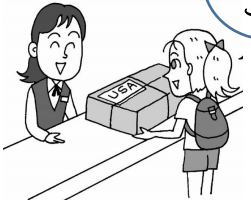Official penultimate lesson before the listening test and oral exam! 😮 We finally finished with Kanji and Lesson #7 – Tasks like Giving and Receiving (last lesson), Lending & Borrowing, Teach & Learn, Sending & Making a phone call.
These are direction related verbs. When talking about a relationship/ action between two people, there is the idea of “from whom” and “to who” *Particle ‘ni | に’ is used in this context. As in previous lesson #8.1, the *particle ‘e | へ’ can be used interchangeably with *particle ‘ni | に’ when talking about directions ‘go | いきます’, ‘come | きます’ and ‘go back | かえります’.
LEND & BORROW | Kashimasu & Karimasu | かします & かります
Conveying Tanaka san lending Satou san a book:

Tanaka lends Satou a book. | Tanaka-san wa Satou-san ni hon o kashimasu. | たなかさん は さとうさん に ほん を かします。
Conveying that Satou borrows a book from Tanaka:
Satou borrows a book from Tanaka. | Satou-san wa Tanaka-san ni hon o karimasu. | さとうさん は たなかさん に ほん を かります。
TEACHING & LEARNING | Oshiemasu & Naraimasu | おしえます & ならいます
Teacher Ayumi teaches Japanese Language to students . | Ayumi Sensei wa gakusei ni nihongo o oshiemasu. |あゆみ 先生 は がくせい に 日本ご を おしえます。
Students learn Japanese Language from Teacher Ayumi. | Gakusei wa Ayumi Sensei ni nihongo o naraimasu. | がくせい は あゆみ 先生 に 日本ご を ならいます。
MAKE A PHONE CALL | Denwa o kakemasu | でんわ を かけます

Conveying that the girl Anne is making a phone call to her boyfriend:
Anne makes a phone call to her boyfriend. | Anne-san wa kare san ni denwa o kakemasu. | アッンさん は かれ に でんわ を かけます。
SENDING ~ | Okurimasu | おくります

Yamada sends a package to her friend in America. | Yamada-san wa Amerika no tomodachi ni nimotsu o okurimasu. | やまださん は アメリカの ともだち に にもつ を おくります。






 Q:
Q:
